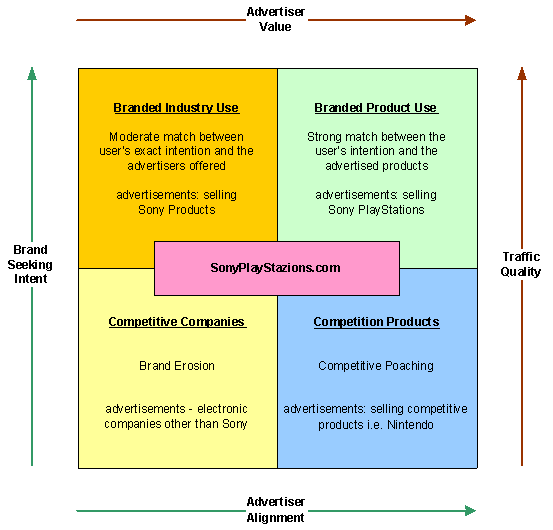|

Case
Study: SonyPlayStazions.com
Ė The user in this case study is evidently looking for
the popular and well branded Sony PlayStation web site.
If they had typed-in either PlayStation.com
or Sony.com
they would have been able to find what they really
wanted. For
the sake of this study let us assume that the domain
would be redirected to a domain parking page instead.
What is the quality and value of this traffic?
The
value of this traffic is directly aligned with how
closely the content provided on the results page is to
the userís intention of finding information on Sony
PlayStations. If
the content on the page is directly related to Sony
PlayStations (Branded
Product Use) then the quality of the traffic and
conversion for advertisers is going to be extremely
high. There
is no better use for this traffic than to sell Sony
PlayStations or associated games and accessories.
If
instead the content served on the page is representative
of Sony Products or Sony Corporation (Branded Industry Use), then the quality of that traffic will be
reduced compared to the most appropriate use.
In reality, the less aligned content has impeded
the intended buying behaviour by offering something less
specific to the user.
Offering
Nintendo or Xbox (Competition
Products) content on the results page would also be
a distortion of the userís intent.
Although the products are loosely aligned with
the userís intent the content is not what they were
seeking. What
if they already own a PlayStation and are really looking
to buy a game? How
likely is it to sell them a Nintendo or Xbox if they
already own the latest PlayStation?
What
would the effect on quality be if the domain parking
page only had advertisements from other electronic
companies (Competitive
Companies) on it?
The resulting advertisements can cause brand
confusion and are not strongly targeted.
Of all the examples given, this solution is the
least aligned with the userís intent and is likely to
encourage the user to shut down the browser and try
something else.
There
are a thousand other ways to handle this traffic that
are even less appropriate, and consequently would
generate even poorer conversions.
They include showing generic landing pages,
adult, or irrelevant content.
None of these are appropriate and the brand
owner, in this case Sony, would be the most effective
and less-offensive to the user in the use of the domain.
Traffic
Quality Ė one
of the common things that has been confused when
discussing branded domains is the difference between the
domain asset value and its traffic quality.
If the traffic from a branded domain is used
appropriately the quality of that traffic can be
extremely high.
When
users type-in a branded domain into the browser address bar, their intention is to
find a specific branded web site that they have already
heard of. In
the case of typographic or spelling errors of popular brands or web sites Ė
the intent is still to find a specific web site - other
than the web site they were directed to.
In the case of typographic error domains the
intent was most likely to find the correctly spelled
domain name and as such the intent is misaligned.
Acronyms
are an interesting case because there is often more than
one company, product or service that is represented. This confusion also tends to create a considerable amount of
traffic, but how targeted is that traffic?
What does GSN.com mean?
It could represent: Genetic Services News, Global
Shopping Network, or Golf Shot Nerds.
The reality is it could mean anything and in-turn
the traffic could relate to anything as well. This
traffic by its very nature needs to be requalified.
The
rule: If the
userís intent is successfully aligned with advertiser
content that addresses the userís specific needs -
then the traffic quality of conversion will be high.
In contrast, if the content is not what the user
is really looking for - then the traffic quality is
reduced.
In
the case of trademark related traffic, it is most likely
that the trademark owners are the most qualified to
convert this form of traffic.
In fact, in many cases this traffic is already
sold back to the trademark owner via advertisements in
the search engines.
Branded
Domain Asset Value
Ė the domain sales aftermarket places a high
importance on the value of the revenue which domain
traffic generates.
In many cases the only valuation considered is a
revenue multiple of the domain traffic revenue.
Of course, this is a very poor way to value
domains. Traffic
is conceptually only the rent collected from the land,
as domains represent the land of the internet.
When valuing real estate buyers do not just look
at the road traffic near the land they are considering
buying. They also look at the neighbourhood, previous
use, and what the zoning is - which are all reflections
of the potential future use of that land.
It takes an exhaustive and lateral view to
understand the true value of a domain, and traffic
revenue is only one of the key criteria.
The
greatest value attributed to a domain is not its traffic
revenue; a domains greatest value attribute is its brand
value. Respectively
the problem with the sales value of branded domains is
that they generally have very confusing or poor
attributable brand value.
*****
Editor's
Note: If you missed Dan Warner's first
article for DN Journal on Traffic
Targeting and Wastage, you can still catch up by
reading it in our Archive by clicking the link above.
|









